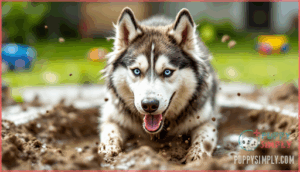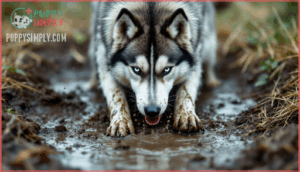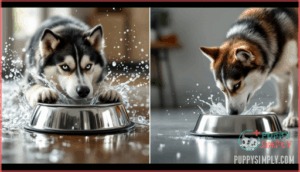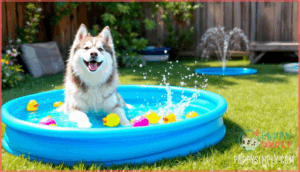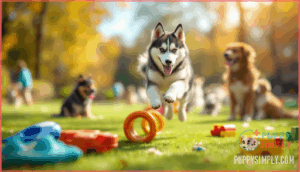This site is supported by our readers. We may earn a commission, at no cost to you, if you purchase through links.

Huskies evolved to dig into snow and ice to create insulated dens and regulate their body temperature in extreme conditions. That thick double coat that kept their ancestors warm in subzero temperatures now traps heat in your living room. When your husky digs in water, they’re following the same cooling strategy their ancestors used to survive.
Understanding the reasons your husky likes to dig in the water helps you address the behavior while respecting their natural instincts.
Table Of Contents
Key Takeaways
- Huskies dig in water because of hardwired survival instincts from their Siberian ancestry, where digging into snow and ice helped them create insulated dens and regulate body temperature in extreme cold.
- Their thick double coat traps heat in warm environments, triggering the same cooling behavior their ancestors used—pawing at water to splash their chest and paws where heat escapes fastest.
- You can redirect this natural behavior by switching to non-reflective or elevated bowls, providing outdoor water play alternatives like kiddie pools, and increasing daily exercise to prevent boredom-driven digging.
- Positive reinforcement training works better than discipline because the behavior isn’t misbehavior—reward calm drinking immediately, stay consistent with timing, and redirect digging to designated outdoor areas where splashing is acceptable.
Why Do Huskies Dig in Water Bowls?
If you’ve caught your husky splashing around in their water bowl, you’re not alone. This behavior might seem odd, but it’s rooted in their unique heritage and instincts.
Let’s look at what drives huskies to turn their drinking water into a mini swimming pool.
Husky Breed Instincts and Ancestral Behavior
Because your Husky’s ancestors survived Siberia’s brutal conditions, digging is hardwired into their DNA. This instinctual behavior comes from genetic predisposition shaped by breed purpose and survival mechanisms. Digging is common because it’s a deeply ingrained behavior for Huskies.
Your Husky’s ancestral drives include:
- Creating snow dens for warmth in sub-zero temperatures
- Exposing cool earth during summer heat
- Hunting small prey beneath snow and ice
- Building protective shelters from harsh winds
- Storing food in frozen ground caches
These Husky breed characteristics explain why Huskies dig so frequently—even in water bowls.
Survival and Cooling Strategies
When temperatures rise, your Husky’s double coat becomes a heat trap that triggers an ancient cooling reflex. Digging into water mimics their Siberian ancestry survival trait of creating cool dens beneath snow.
This instinctual behavior aids heat regulation through environmental adaptation. Your Husky’s cooling strategies include pawing at water to splash their chest and paws—areas where heat escapes fastest.
It’s not misbehavior; it’s hardwired Huskies digging behavior seeking shade-like relief when overheated.
Differences Between Huskies and Other Breeds
Unlike most dog breeds, your Siberian Husky carries genetic adaptations that make water digging almost inevitable. Their dense double coat retains heat far more than single-coated breeds, triggering cooling behaviors when temperatures exceed 77°F.
Other breeds lack this ancestral wolf lineage and don’t share the same working drive or energy levels—Huskies need two-plus hours of daily exercise compared to companion breeds. These temperament traits and genetic health factors mean your Husky’s digging behavior reflects breed-specific instincts, not poor training.
Huskies share traits with other breeds that are also loyal and playful.
Common Reasons Huskies Dig in Water
Understanding why your husky digs in water helps you address the behavior effectively. Several factors can trigger this instinct, from their natural cooling needs to simple boredom.
Let’s look at the most common reasons behind this messy habit.
Heat and The Need to Cool Down
Think of your Husky as a walking fur coat in summer heat. Their thick double coat traps warmth, pushing body temperature up to 37.9°C after activity. Water immersion helps them cool down fast, dropping temperature by about 0.42°C.
This isn’t just comfort—it’s survival. When temperatures hit 32°C, mortality risk jumps 10%.
When temperatures hit 32°C, your Husky’s water digging isn’t misbehavior—it’s a survival instinct that reduces mortality risk by 10%
Your Husky digs in water bowls using the same cooling protocols their ancestors relied on in Siberia, making it a hardwired thermoregulation method rather than bad behavior.
Attraction to Reflections and Moving Water
Your Husky’s fascination with that shiny stainless-steel bowl isn’t random—it’s driven by reflections that trigger their prey drive and a natural preference for water that looks alive.
Here’s what’s happening:
- Reflective bowl types act like mirrors, bouncing light that mimics prey movement
- Visual stimuli impact activates hunting instincts when shadows shift across water surfaces
- Moving water benefits signal freshness to your dog—still water means stagnant in nature
- Instinctual water response drives digging to create ripples and movement
- Alternative water sources like fountains satisfy this craving without the mess
Boredom and Lack of Stimulation
When mental and physical exercise fall short, even the calmest Husky often transforms their water bowl into an entertainment project. Activity deprivation hits this breed especially hard because Huskies’ mental stimulation and exercise needs are intense—they were bred to run across tundra for hours.
Without proper playtime importance and mental enrichment through dog boredom solutions like puzzle toys or training sessions, your dog creates their own mental challenge. Water digging becomes destructive behavior born from dog boredom and entertainment deficits, not defiance.
Attention-Seeking and Compulsive Behaviors
Some Huskies splash their bowls for a quick reaction from you, while others develop patterns that cross into compulsive territory. If your dog seeks attention cues through this behavior, ignoring digging often eliminates the reward.
But compulsive digging requires behavioral therapy and redirection methods. Watch for obsessive patterns—compulsive behavior demands professional dog behavioral tips, not just training adjustments.
How Digging in Water Affects Your Husky
You might think digging in water is just messy or annoying. But it can actually create real problems for your husky’s health and behavior.
Let’s look at three key concerns every husky owner should understand.
Hydration and Health Risks
Digging splashes water everywhere, which means less clean drinking water for your husky. Dogs need about one ounce of water per pound of body weight daily, so even small losses matter. Water contamination from dirt or bacteria can lead to pathogen transmission and illness.
Bowl cleaning daily helps prevent biofilm buildup. Watch for dehydration signs like dry gums or lethargy, especially during hot weather when heatstroke prevention becomes critical for dog health.
Behavioral Reinforcement Concerns
Every time your husky paws at that water bowl and you react, you’re teaching them that splashing gets results. Laughing or scolding both count as attention, fueling dog attention-seeking behavior.
Inconsistent reinforcement confuses them about what’s okay. Overcorrection risks can make things worse. Extinction bursts—when digging temporarily intensifies—happen when you first ignore compulsive dog behaviors.
Understanding dog psychology helps you avoid these punishment pitfalls and reshape dog behavior problems effectively.
Mess and Cleanliness Issues
Splashed floors, soaked rugs, and puddles tracking through your house—water bowl digging turns a simple drink into a daily cleanup disaster. Water spillage creates mud tracking problems when Huskies step from bowl to floor.
Poor bowl hygiene from constant pawing encourages mold growth in damp areas.
Surface damage to hardwood or laminate floors happens when water sits unnoticed.
Addressing this digging behavior protects your home and keeps your dog’s water bowl solutions clean.
Solutions to Stop Water Bowl Digging
If your husky won’t stop splashing and pawing at their water bowl, you’re not alone. The good news is you can redirect this behavior with a few simple changes.
Here are practical solutions to help you manage water bowl digging and keep your floors dry.
Switching to Non-Reflective or Elevated Bowls
By choosing the right water bowl, you can reduce your husky’s urge to paw and play. Non-reflective bowls eliminate shiny surfaces that catch your dog’s eye, cutting pawing behavior by 50%. Stainless steel or solid-colored options work best for reflection reduction. Elevated designs also discourage digging by making access harder.
- Spillage control: Heavy, non-slip bowls reduce water spills by 70%
- Behavioral impact: Non-reflective surfaces decrease digging attempts by 55%
- Hygiene improvement: Stainless steel bowls lower bacterial load by 33%
- Ergonomic benefits: Elevated bowls ease neck strain in older huskies
- Mess prevention: Splash-resistant designs keep 80% more water inside
Providing Outdoor Pools or Water Play Alternatives
If your husky still acts like a water park enthusiast after you’ve upgraded their bowl, giving them a real place to splash can redirect that energy where it belongs. A kiddie pool or dog pool offers supervised playtime while satisfying their cooling instincts. Choose shallow options for pool safety and add water toys to keep things interesting.
These dog cooling strategies work better than any dog water bowl solutions when your husky’s digging won’t quit.
| Pool Types | Best For |
|---|---|
| Kiddie pool | Budget-friendly DIY pools |
| Foldable dog pool | Easy storage and portability |
| Hard plastic pool | Durability and year-round use |
| Splash pads | Supervised playtime without standing water |
| Swimming pool access | High-energy huskies needing serious exercise |
Increasing Exercise and Mental Stimulation
Beyond the splash zone, a tired husky is a well-behaved husky—and ramping up their daily workout routine can cut down on boredom-driven digging before it starts. Huskies’ exercise needs include both physical and mental challenges that prevent destructive behaviors.
- Puzzle Toys: Hide treats inside to engage problem-solving skills
- Agility Training: Set up obstacle courses for physical exercise and focus
- Scent Work: Create tracking games that tap into natural instincts
- Socialization Playdates: Arrange meetups with other dogs for interactive games
- Interactive Games: Use fetch or tug-of-war for dog mental stimulation
Using Water Fountains for Moving Water
Some huskies just can’t resist the allure of moving water—and that’s where a pet fountain can save your floors and satisfy their craving for a little action. Fountain benefits include constant circulation that mimics natural streams your husky instinctively prefers.
Choose ceramic or plastic fountain types based on your dog’s size and chewing habits. Regular cleaning prevents bacteria buildup and promotes dog health and hydration while placement matters—position it away from food bowls to reduce mess.
Training Tips and Preventive Strategies
Training your husky to stop water bowl digging takes the right approach and a bit of patience. The good news is that you can redirect this behavior with proven techniques that work with your dog’s natural instincts.
Let’s look at some practical strategies you can start using today.
Positive Reinforcement Training Methods
You can reshape your husky’s digging habit using positive reinforcement—the best approach in dog training methods. Reward your dog immediately (within 2 seconds) when they drink calmly without pawing, and you’ll see real progress.
Training sessions work best when you:
- Keep practice short at 5–10 minutes to boost retention
- Mix up rewards with treats, toys, and praise to maintain interest
- Stay consistent with timing so your husky connects the reward to calm drinking
Studies show 80% of dogs improve with positive reinforcement, and behavioral issues fade as your husky learns what earns praise. Patience matters—shaping behavior takes repetition, but consistency importance can’t be overstated. Once your dog generalizes skills across different situations, the digging stops for good.
Ignoring Attention-Seeking Behavior
When your husky splashes water everywhere just to get a reaction from you, ignoring that behavior becomes your strongest training tool. Turn away immediately and avoid eye contact until the splashing stops. Consistency is key—even quick glances reward attention-seeking behavior.
After 30 seconds of ignoring, redirect to alternative behaviors like drinking calmly. Your reaction either feeds boredom or builds better habits through positive reinforcement.
Redirecting Digging to Designated Areas
Instead of battling your husky’s natural urge to dig, channel that energy into a space where splashing and pawing won’t wreck your floors. Creating a digging spot outdoors satisfies this instinct while stopping digging behavior where it’s unwanted.
Setting up your designated digging area:
- Area introduction – Choose a sandbox or dirt patch away from gardens
- Material selection – Use sand or loose soil that’s easy to paw through
- Digging incentives – Bury treats or toys to make the spot irresistible
- Training techniques – Guide your husky there when digging starts elsewhere
- Maintenance tips – Keep the area fresh and rewarding with regular additions
Providing digging areas works best when paired with consistent redirection and praise.
Consistency and Patience in Behavior Management
Changing your husky’s behavior takes time, and expecting instant results will only leave you frustrated. Training setbacks are normal and part of habit formation. Realistic expectations matter because canine behavior doesn’t shift overnight.
Gradual progress through consistent dog training techniques shows your long-term commitment is working. Stick with solutions for dog digging using the same approach daily, and stopping dog digging becomes achievable with patience.
Frequently Asked Questions (FAQs)
Can water digging indicate underlying anxiety issues?
Yes, water digging can signal anxiety in your dog. Stress indicators like compulsive digging may stem from separation anxiety or environmental stressors.
Compulsive behavior often requires behavioral therapy and environmental enrichment. Watch for other stress signs to identify anxiety triggers early.
How does water temperature affect digging behavior?
Water temperature plays a direct role in digging behavior. Ideal Water Temperature between 50-60°F discourages digging, while warmer water above the Digging Threshold Temperature of 77°F triggers cooling instincts.
Your husky’s Breed Temperature Tolerance and Water Temperature Preference drive this behavior—cold water satisfies their Cooling Efficiency needs better than lukewarm bowls during summer.
Are certain water bowl materials safer than others?
Think of choosing a bowl like picking the right tool for the job—some materials just work better. Stainless steel bowls resist bacteria growth and offer excellent cleaning ease, but check for material toxicity in cheaper metals.
Ceramic options provide chew resistance and reduce dog water bowl digging from reflections, though they require careful allergy concerns monitoring.
Glass and certain plastics work for pet water fountains, prioritizing pet safety and pet health above aesthetics.
Should I discipline my husky for water digging?
No, discipline isn’t effective for water digging. This dog behavioral tip highlights breed considerations: huskies dig instinctively, not to misbehave.
Punishment creates reinforcement dangers and ethical implications. Instead, use positive dog training methods—redirect destructive behavior, address boredom, and swap your water bowl for alternatives.
Does water digging worsen with age or improve?
It depends on environmental factors and changing needs. Digging frequency often decreases as joint problems or cognitive decline develop with age.
Some Huskies maintain breed differences in water digging habits throughout life, while others improve with consistent dog behavioral tips and training.
Conclusion
Like a cold drink on a hot day, understanding the reasons your husky likes to dig in the water brings relief to both you and your dog. Their ancient instincts don’t disappear in modern homes. They just need the right outlets.
Swap reflective bowls for elevated ones. Add outdoor water play to their routine. Increase exercise and mental challenges. These simple adjustments respect your husky’s hardwired behavior while keeping your floors dry. When you work with their nature instead of against it, everyone wins.
- https://www.eastvalleyanimal.com/how-do-dogs-stay-cool/
- https://beyondthedogtraining.com/dallas-dog-friendly-guide/why-do-dogs-dig-and-how-to-manage-this-behavior/
- https://k9apparel.com/blogs/resources/how-do-dogs-regulate-temperature
- https://www.nbcnews.com/health/health-news/signs-dog-intelligence-gifted-dogs-play-study-finds-rcna41534
- https://www.petcircle.com.au/discover/why-does-my-dog-paw-at-their-water-bowl

